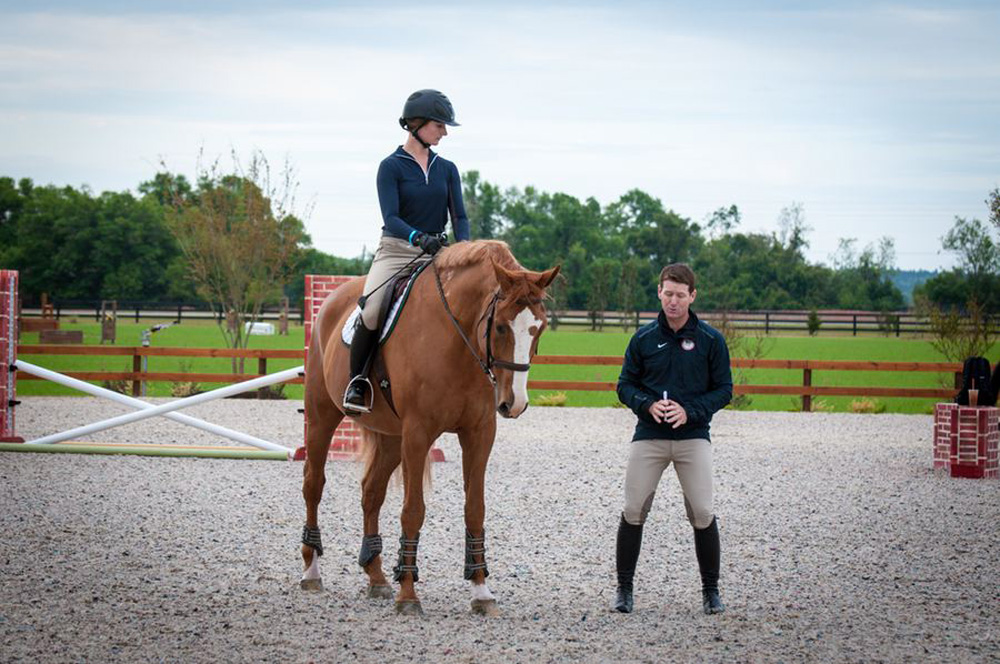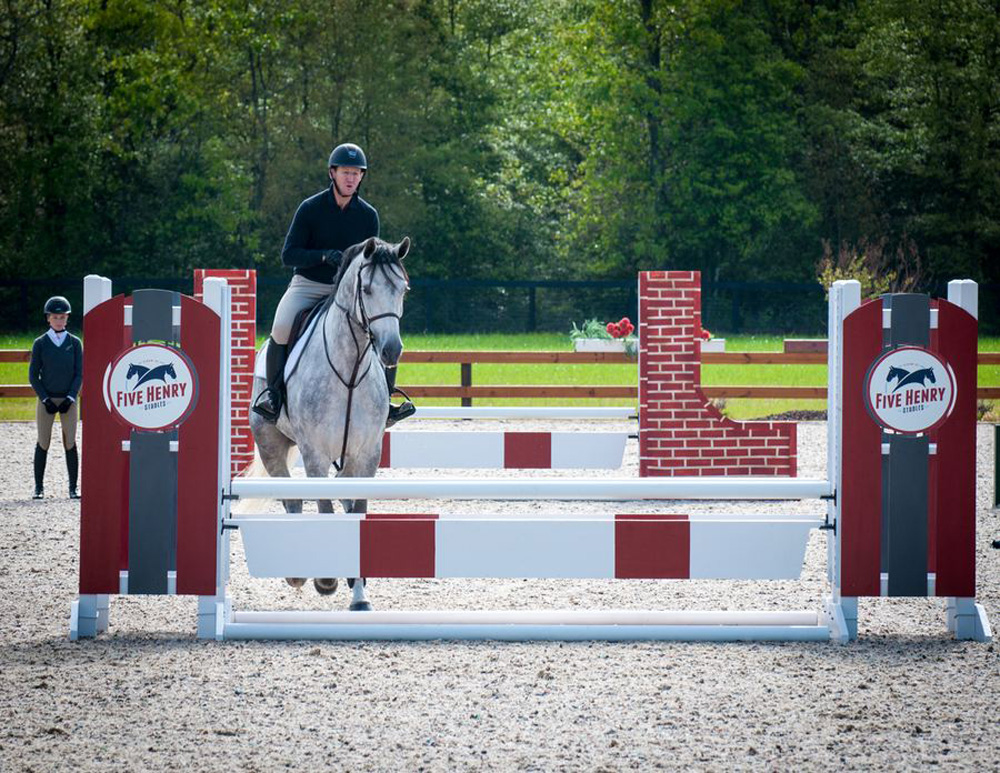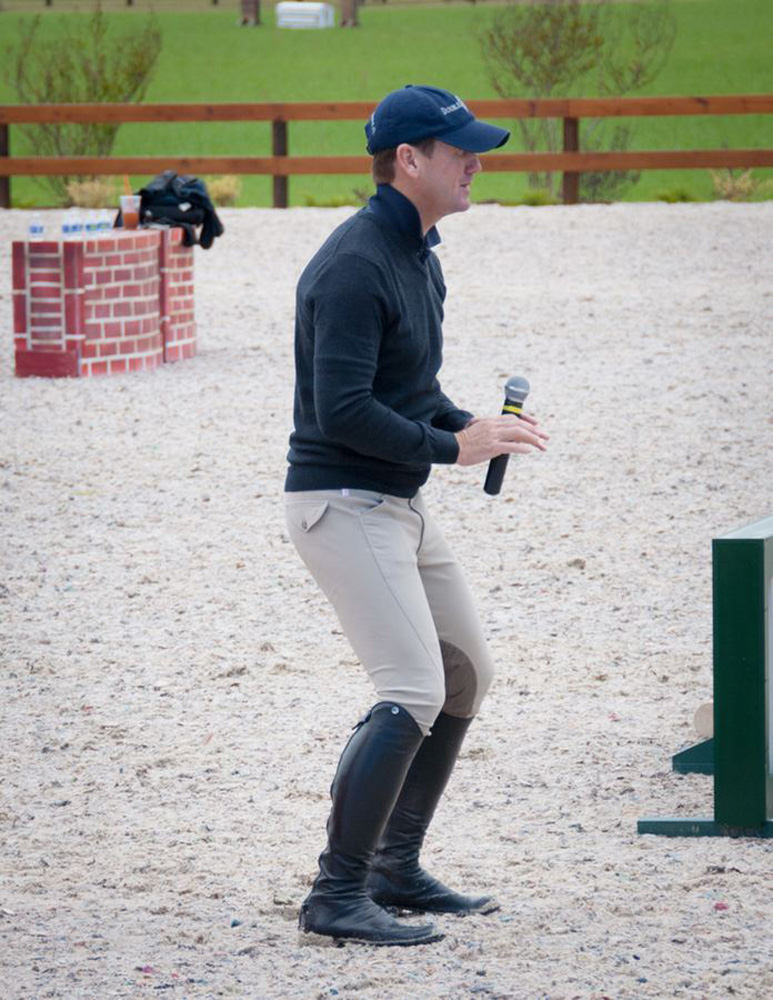Success at the grand prix level doesn’t come from tricks or magic potions, two-time Olympic gold medalist McLain Ward emphasized on the opening day of his recent show jumping clinic at Five Henry Stables in Aiken, S.C.
“Our training is not some wizardry,” Ward said. “It’s simple basic horsemanship that helps every horse go well.”
Twenty-five riders participated in four different sessions with Ward on April 14. Given Ward’s emphasis on discipline, details and the basics it was no surprise to the group that Day 1 focused entirely on gymnastics.
“In training, we can do everything we need in a simple line. We need the horses to be straight, and go forward and backward,” Ward explained. “We don’t need a grand prix course to [teach them to] do that.”

McLain Ward explained a concept to Wynne Weatherly on her Rio Oro. Photo by M Timmerman Photography.
Ward is one of the most successful riders on the international showjumping circuit, having won team Olympic gold in 2004 and 2008, team World Equestrian Games silver in 2006, and team bronze and individual gold medals in the 2015 Pan American Games (Toronto). He says this success is based on a training system that focuses on gymnastics. “Our organization, this is one of our strengths. This system is what we go back to when something goes wrong,” he said.
“Today we are going to use the same programs that I use with my horses, starting with the fundamentals,” he told the riders in Aiken. He pointed to a row of three vertical fences, set at one-stride distances. “This gymnastic is what Rothchild jumps before every grand prix. Perhaps a bit bigger, but this is how we train,” Ward said.
Like A Bump In The Road
In each session, Ward had the riders warm up on the flat, then start jumping by cantering over a simple cross-rail. Despite the wide range of rider experience in the clinic, they had one thing in common: most of the riders displayed too much movement in their upper bodies.
“You guys look like you are trying to jump the water at Aachen. How high is that fence, a foot and a half?” Ward chided them. He added that “overextending the body” in the air made it harder to recover on landing, and made their horses jump flatter.
“Treat the fence like a bump in the road. In your mind’s eye, imagine that his wither is coming up to your chest bone,” he coached several riders. “Your horse is coming up to you. You are not going down to him.”
ADVERTISEMENT
During the morning sessions, a cool wind blew up the skirts of some of the younger horses. Ward addressed the need to ride different horses, in different conditions.

McLain Ward rode a few of the horses in the clinic to help clarify some of their issues. Here he’s on Confire as Jane Garvey watches. Photo by M Timmerman Photography.
“People talk about a certain rider that has ‘feeling.’ But that is a loose term, what does it mean? It’s hard to teach feeling; it’s too abstract,” he said.
“Feeling is a scale of 1 to 10 in your aids and connection to the horse. It is your seat, your lower leg pressure, your hands, on a scale of 1 to 10. Feeling is understanding the degree of all the things your horse needs.”
He explained that a hot horse may need 1 with the leg, 0 with the seat, and 7 with hand contact. And that a quieter horse may need 7 or 8 with the leg, and a 2 with the hand. “You have to determine the degree of those scales with every horse,” Ward explained.
A bit later, Shari Dell had a chance to demonstrate this directly. Her mount Fellow was reacting to her deep seat and not getting down the line of a five-stride combination.
“You have to be able to change your seat, get up out of your saddle and let a blood horse open up his stride,” Ward told her. “You can’t force a blood horse to open his stride—he will punch out the front rail of every oxer, I promise you. You have to just allow him to do it.” With this advice Shari was able to adjust her ride, and Fellow relaxed and made his distances smoother.
Never Compromise Your Position
Ward worked closely with junior rider Jane Garvey and rode her mount, Con Fire, who was getting quick off the ground while cantering a figure-eight pattern over a vertical and small oxer. “We have to watch in riding difficult horses that we don’t compromise our own position, we don’t pick up their bad habits
“No matter what he does or how he speeds up I don’t change,” Ward said as he rode Con Fire. “My position or contact doesn’t change. I may take a lighter seat, but just because he is getting quick, I am not getting quick. My release, my contact, my body is all in the right place.”
He emphasized that good position, no matter how the horse is behaving, is the “base of all riding.”
ADVERTISEMENT

McLain Ward emphasized the importance of a solid basic postition. Photo by M Timmerman Photography.
“Everyone says, ‘Oh, that person has a great eye.’ So what? That doesn’t matter,” Ward added. “Anyone can learn to find a distance. At the highest level, no one misses. But the riders who have the great balance and the great position, over the long term, over many different horses, are the ones who win.”
Give Him A Chance To Be Good
As the sessions progressed, the fences got higher and exercises more demanding. Ward was clear that he wanted the tests to be challenging but doable for the horses. “Give the horse a chance to be good—why set them up for disaster?” he said.
Ward went on to explain that he couldn’t ask his legendary mare Sapphire to do lead changes on the flat because it made her too nervous. And that Rothchild was too sensitive to do a lot of intense flat work. “I am not going to ask Rothchild to do a shoulder-in for half an hour. That would have been the end of Rothchild. Or maybe the end of me.” he joked.
“I try to only ask what the horse can give me. And understand that on certain days he can give me more, just like people. Rothchild taught me that.”
The grand prix group rode last, and the focus was less on the rider, more on the horse. “Let’s make the horse be the best he can be through our training,” Ward said in opening the session.
The riders addressed a new four-fence gymnastic with a bounce to a one-stride, and then to a two-stride. For many of the riders, the most challenging part was a canter pole placed 9’ before the first vertical.
“A canter pole is the nemesis of many a rider,” Ward warned the group. “Even Beezie Madden, and she is one of the best in the world, she can’t ride one. And she’ll admit that to you!” Ward said, smiling. When rider Lincoln Russell, riding Catalina, struggled through the exercise, Ward coached him to look at the pole, not at the fences beyond. “Everyone wants to get anxious and focus on the jump, but be patient.”
“This pole is not going to decide whether or not you win grand prix [classes],” Ward explained to Russell as he continued to practice the exercise. “But it is a discipline and you are good enough to do it. Make the simple things correct even though you are good enough to get away with it.”
Be sure to check back at www.coth.com tomorrow for coverage of Day 2 of the McLain Ward clinic at Five Henry Stables.















